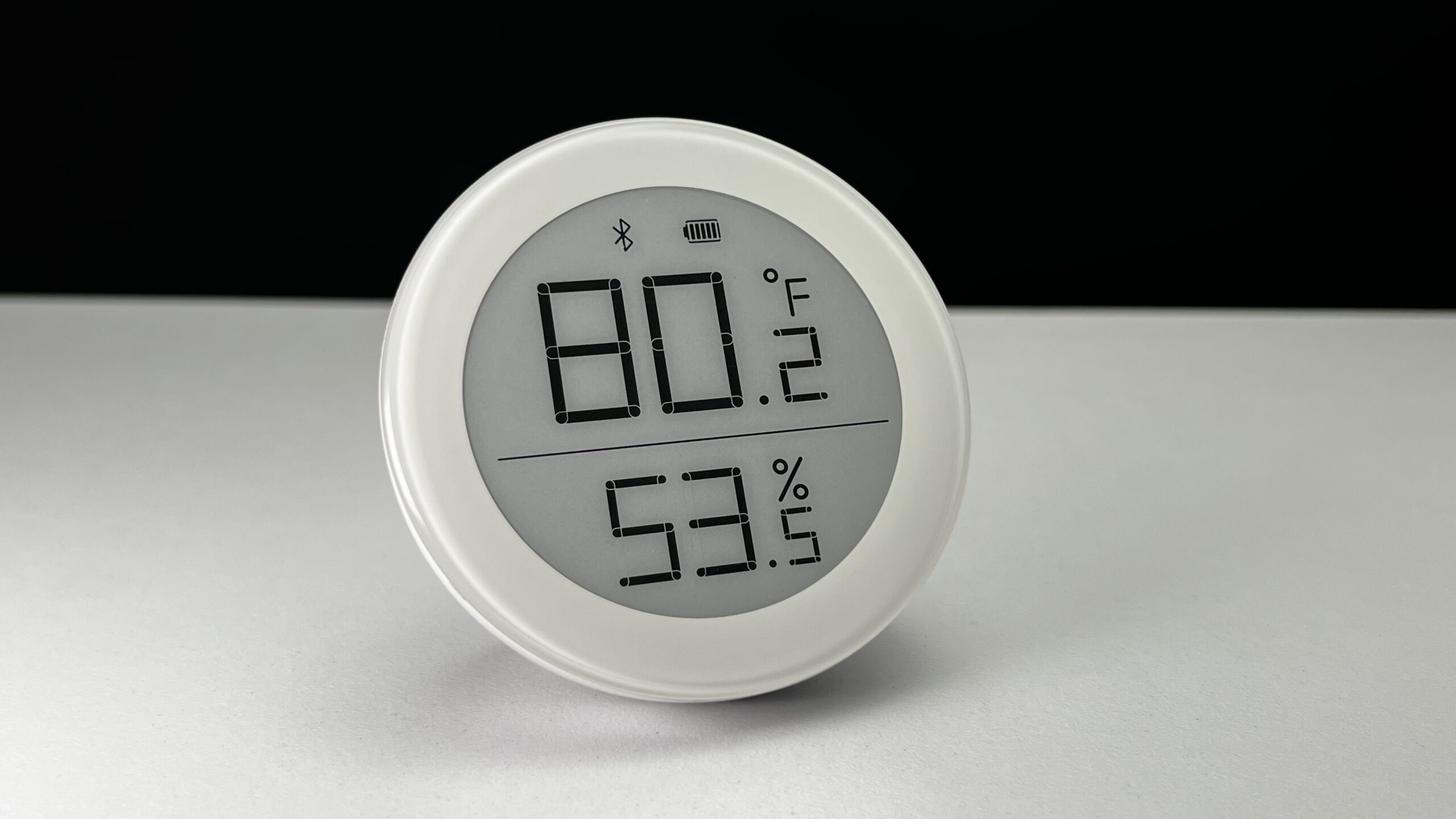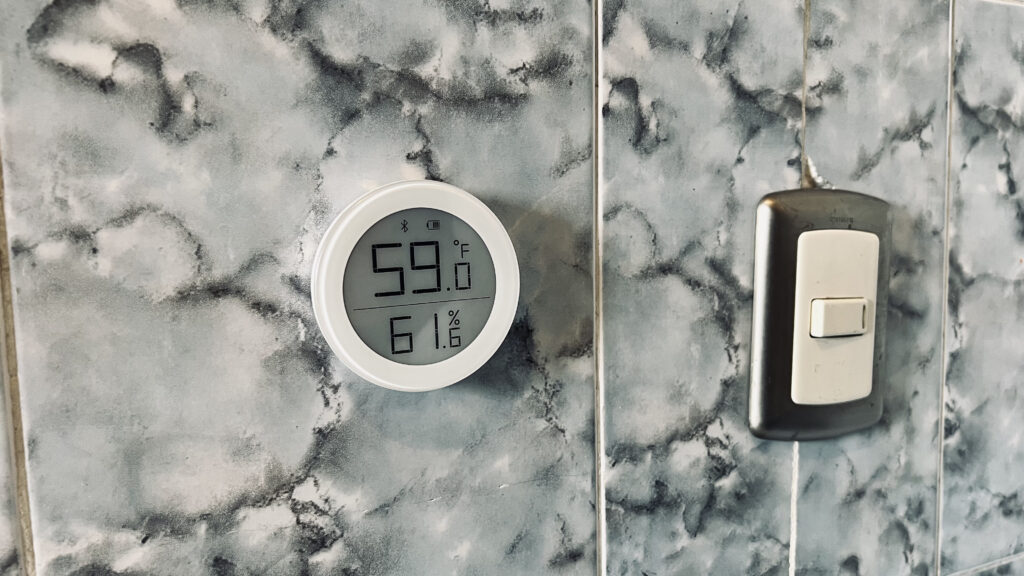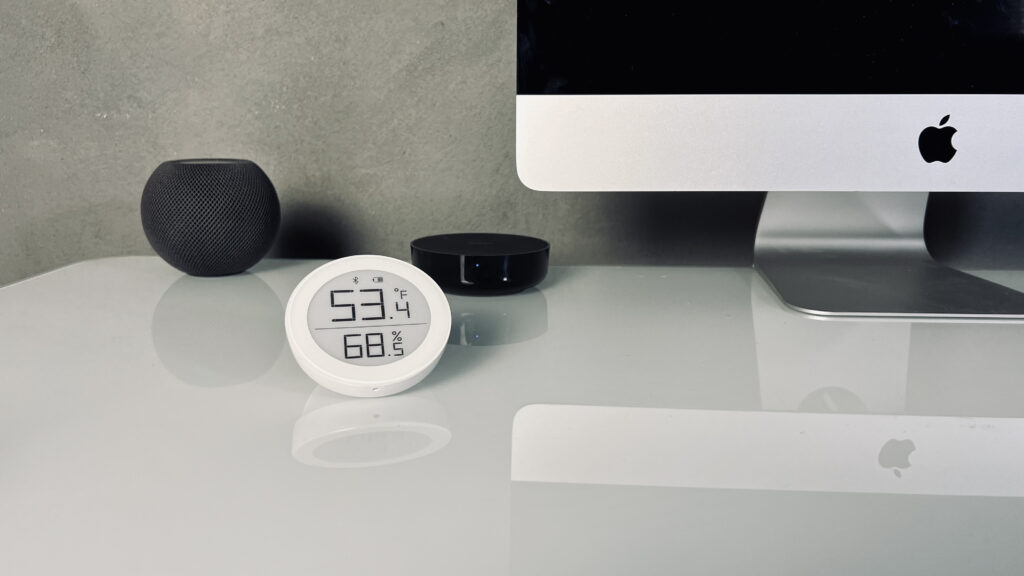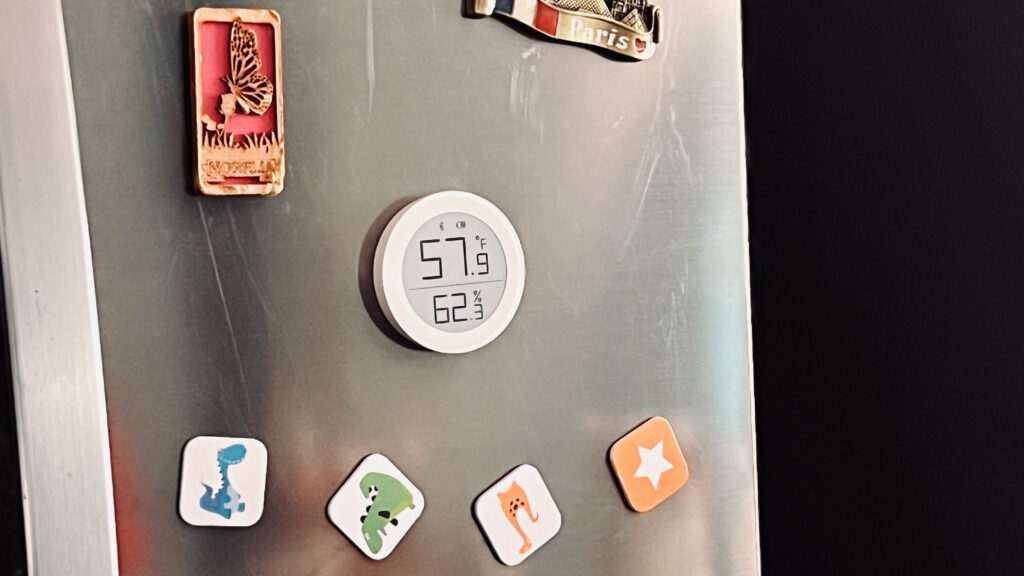Temperature and humidity Sensors in HomeKit are becoming almost as commonplace as smart plugs these days. With Apple exposing the built-in environment gauges in the HomePod second gen. And the HomePod mini, Apple Home users can now easily automate everyday appliances like fans or humidifiers. However, checking in on the room’s temp doesn’t have to involve tapping your way through numerous screens in an app nor disturbing the peace by hollering at Siri. The QingPing Temperature and Humidity Sensor let’s you quickly see your indoor environment while adding a stylish adornment to your abode.
Features
- temperature & humidity sensor
- Large eInk display
- Flexible mounting design including adjustable kickstand, magnetic attachment, or double-sided tape
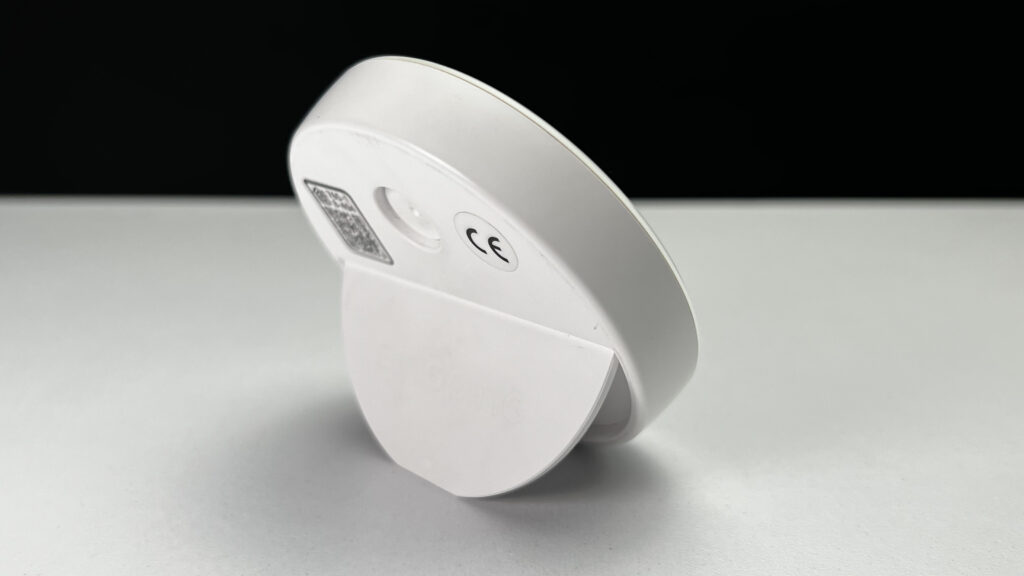
Need to Knows
- 1 x CR2430 battery lasting approximately 8 months
- Bluetooth connectivity (Thread version now available!)
Pros
The QingPing temperature and humidity sensor stands out from the pack in three main ways. First is its circular design. The vast majority of other similar environment sensors in Homekit are square or rectangular, so it’s refreshing to have a change of pace.
Next up is that display. It is up front and center and let’s you know how hot, cold, dry or wet it is instantly with just a peek. eInk displays are well known for their ultra-high contrast, for most people anyway, flexible viewing angles, and low energy consumption making them ideal for this type of device.
Lastly, and I think what is the most interesting aspect of the design of the QingPing Temperature and Humidity Sensor, is its various mounting options. Being circular, you might think it would be impossible to set on a desk or shelf. QingPing solved this by adding an adjustable kickstand to the back side which folds away neatly for vertical mounting. Speaking of mounting on a vertical surface, you have two options. First, the Temperature and Humidity Sensor comes equipped with magnets allowing you to attach t to metal surfaces. It also comes with doubled-side 3M tape if you are looking to more permanently affix the sensor.
Cons
The QingPing Temperature and Humidity Sensor really does not have anything bad going on, but I suppose we can get a little picky if you’d like. First, let’s discuss the battery. It’s rated for 8 months which I don’t think is unreasonable, though I would like at least a year before having to swap out the batteries. Doing so, however, is a breeze since all of the mounting solutions have taken this into consideration. Others have mentioned that the battery life seems to quickly drain, but I’ve had mine for at least 6 months and although there was an initial drop off in what was reported in Apple Home, it has since stabilized. While it is nice to have battery levels in Apple Home, I do not trust them at all. Many of my devices have been showing 1% for months and still function without a hitch.
My other issue with the battery is the cell type chosen, CR 2430. A large portion of my smart home runs on coin-cell batteries like CR1632, CR2032, and CR2450, but not CR2430. This is in fact the ONLY device in my home that requires this size battery. While I will obviously go out of my way to purchase replacements specially for this accessory, it is a little irritating that I can’t just dip into my stockpile of batteries when I need a quick swap.
The next “downside”I want to bring up is more anecdotal than anything, but my mother-in-law actually confused this sensor as a thermostat. I’ve mentioned on a number of occasions my beloved in-laws battle with my smart home, but this one was understandable. The QingPing Temperature and Humidity Sensor is round like a lot of modern thermostats and it has a large display with the temperature. I can’t really blame her for confusing it and if I didn’t;t know any better, could definitely take this sensor for an A/C controller.
To finish off my fuming, what’s the deal with Bluetooth? It’s a subpar standard for smart home devices and is soo 2010. What’s that? QingPing has added a Thread radio to the sensor. Well, that shut me up quick.
The Apps

I’m a sucker for simple designs and the QingPing+ app is that, yet packed with just the right amount of data and control.
The first thing you’ll notice is that you can either create an account or skip that step altogether which I really appreciate and definite did. Once you’ve gotten your device setup with a nearly stock HomeKit accessory setup process, if you didn’t already add it in Apple’s Home app, you notice that you get a quick readout of the sensor’s levels. You also get some quick recommendations on ways to improve the air quality based on the levels which is not something I’ve seen in other apps. I quite like this, but if you don’t you can toggle recommendations off through the ‘Settings’ tab.
As you might expect, tapping on the device you get a ton of historical data from 24-hour, 7-day, and 1-month periods. This can be really useful for analyzing if steps you are taking to improve your air quality are having an impact or maybe there are some areas in your indoor environment that need some extra care.
Also notable in the app is the ability to adjust how sensor data is displayed on the device. You can change the temperature units to your liking here or you can also do so by tapping the only physical button found on the backside of the sensor.
In Apple’s Home app, both temperature and humidity sensors are exposed and have their own accessory tiles. Each of the tiles displays the current sensor’s measurements, that is if you don’t have multiple sensors in the same room in which case just tap on the category tile to find what you’re looking for.
As this is a battery-powered device, we can see the “current” battery level in both accessory tiles. Though not in Apple’s Home app, we can use this battery level as a trigger for automations in apps that take advantage of this characteristic in HomeKit.
Accessibility

I was very pleasantly surprised to find that the QingPing+ app was incredibly well designed for accessibility with its navigability being intuitive and its semantic structure being properly tagged. All buttons were also labeled and even the data records were easily understood using VoiceOver.
This is a shining example of how incorporating accessibility features does not have to affect an app’s overall design. Especially for smaller vendors, this is not something I usually expect, so I really have to commend QingPing here.
Final Thoughts
So, who should add the Temperature and Humidity Sensor to their Apple Home? Honestly, everybody. It is a very solid way of keeping tabs on what’s going on with your air’s heat and moisture levels. You can create simple and even complex automations that control fans and heating and cooling systems so you can do your best to keep the in-laws content. Let’s not overlook the aesthetics of this sensor either. It looks good no matter where you place it and you can put it almost anywhere thanks to its thoughtful mounting design. If you’re in the market for a temperature and humidity sensor, definitely consider the QingPing Temperature and humidity Sensor. Just make sure you get the Thread version!
We use income-earning affiliate links.
We may receive a small commission on purchases made using links on this page at no extra cost to you.
